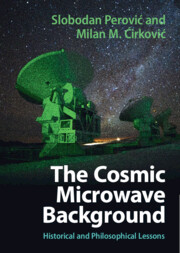Book contents
- The Cosmic Microwave Background
- The Cosmic Microwave Background
- Copyright page
- Epigraph
- Contents
- Acknowledgments
- Introduction
- Part I Physical cosmology: A brief introduction
- Part II Discovery of the CMB and current cosmological orthodoxy
- Part III What constitutes an unorthodoxy? An epistemological framework of cosmology
- Part IV Moderate unorthodoxies: The CMB with the Big Bang
- Part V Radical unorthodoxies: The CMB without the Big Bang
- 18 Motivations
- 19 Hoyle–Narlikar theory and the changing masses origin of the CMB
- 20 Revised steady state
- 21 Closed steady-state models
- 22 CMB in plasma cosmology
- 23 CMB in non-expanding models
- Part VI Formation of the orthodoxy and the alternatives: Epistemological lessons
- Part VII Other philosophically relevant aspects of the CMB
- Book part
- Notes
- References
- Index
20 - Revised steady state
from Part V - Radical unorthodoxies: The CMB without the Big Bang
Published online by Cambridge University Press: aN Invalid Date NaN
- The Cosmic Microwave Background
- The Cosmic Microwave Background
- Copyright page
- Epigraph
- Contents
- Acknowledgments
- Introduction
- Part I Physical cosmology: A brief introduction
- Part II Discovery of the CMB and current cosmological orthodoxy
- Part III What constitutes an unorthodoxy? An epistemological framework of cosmology
- Part IV Moderate unorthodoxies: The CMB with the Big Bang
- Part V Radical unorthodoxies: The CMB without the Big Bang
- 18 Motivations
- 19 Hoyle–Narlikar theory and the changing masses origin of the CMB
- 20 Revised steady state
- 21 Closed steady-state models
- 22 CMB in plasma cosmology
- 23 CMB in non-expanding models
- Part VI Formation of the orthodoxy and the alternatives: Epistemological lessons
- Part VII Other philosophically relevant aspects of the CMB
- Book part
- Notes
- References
- Index
Summary
Narlikar and Wickramasinghe’s 1968 version of steady state theory made use of the dust grains hypothesis, while arguing that the precise measurements of the CMB spectral shape deviate from the black body shape. As critics pointed out, an unrealistic consequence of the model (CMB exceeding visible radiation by a factor of 100) was Wickramasinghe’s 1975 version; it included a very detailed account of elongated whiskers as thermalizers that compose cosmic dust. The 1990s version of steady state constructed by a larger group of authors – the usual proponents of the steady state – introduced the discrete creation of matter (“mini bangs”) in the cellular form of observed galactic structures. The motivation was to eliminate the epistemically problematic singularity of the Hot Big Bang, explain creation of matter as an inherent feature of physical laws, and introduce strong gravitational fields of galactic nuclei as the sites of synthesis of atomic nuclei (with a detailed description of the mechanisms of nucleosynthesis). The chapter discusses a number of combinations of steady state, Population III as sources, and dust grain thermalizers devised until early 2000.
Keywords
- Type
- Chapter
- Information
- The Cosmic Microwave BackgroundHistorical and Philosophical Lessons, pp. 113 - 117Publisher: Cambridge University PressPrint publication year: 2024



